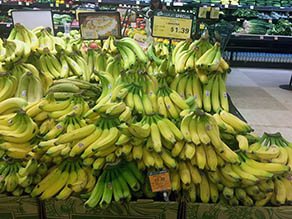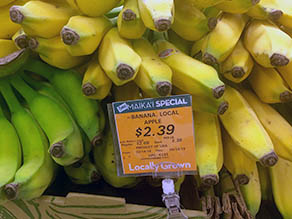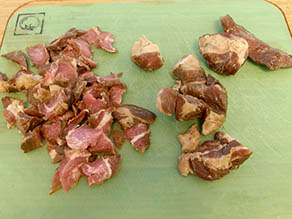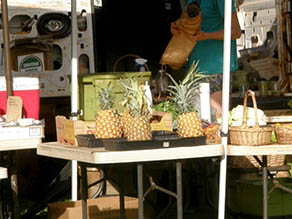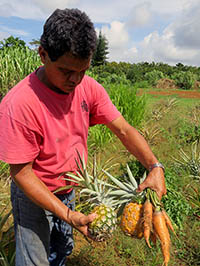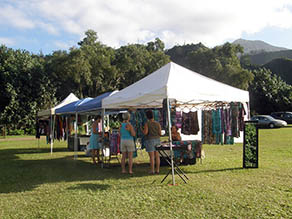 |
 |
 |
 |
||||||
|
|
|
|
|
|
|
|
|
|
| People | Environment | Invasives | Food Today | Sovereignty | Language | Sources & Links | |||||||||
 |
|
 |
|||||||
 |

“Currently almost all of our food is being shipped to Hawai‘i,” Donovan states. “What’s locally produced for consumption in the market is near zero. The local farmer, because his land is at a premium, has to pay a lot just to be on the land. It blows me away that we’re the only species on the planet that have to pay to be on it. Monkeys don’t have to pay, dogs don’t have to pay, and I know that it’s due to the amount of damage that we do. If we weren’t doing the kind of damage that we’re doing to the planet, the people who are charging us to be here wouldn’t see a need for us to be charged to live here. If we weren’t occupying so much space frivolously the way we do without any thought, or, ‘I like that place, let’s go live there,’ without taking into consideration what the community is like there before—we see that here. 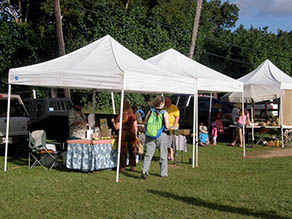
“That happens here all the time—people come here thinking ‘Wow, that’s such a beautiful place, I want to live there.’ And then they come. And instead of embracing the community that they moved to, they come with all their baggage and they want to impose what they knew in their old place on the situation here. And that happens everywhere around the world, that’s not a systemic problem here in Hawai‘i, that’s a systemic problem all over. And again, connected to the ego: my lack of ability to be humble in my new surroundings, I got to pronounce myself, ‘Now I’ve arrived,’ and it’s ridiculous. “So that’s the situation we see with all food production. Farmers don’t have the freedom and ability to produce food at the level that they would like to. They don’t have access to the distribution of the food that they are producing, which is also lends to the exclusivity of the food that is being produced at the local level. You’ve got to be local to be able to get to it, and that’s going to drive up the price. The fact that there is so little being produced drives up the price. So you go to the market and you have a locally produced whatever it is, sitting next to something that was shipped in from somewhere else—bought it in bulk—that’s fifty-percent less in a lot of cases than what’s being produced locally. “We grow bananas here in Hawai‘i, but when you go to the super market, one little tiny bin that’s five inches by five inches that can fit maybe four, five hands of locally produced bananas from Hawai‘i, from my neighbor. The rest of the table, which is six-foot by six-foot, all the bananas are Dole bananas grown in Costa Rica, which were picked green, fumigated to turn yellow then shipped to Hawai‘i. What are you going to buy, especially if you’re poor? And so again we see locally produced food, organically produced food all around the world becoming something that is elitist. “And it’s not because its elitist thing, it’s because that’s what we want, that’s the real food, not the food that we are being fed now. But because not enough of it is being produced to feed the people, only the people with money are able to afford it. We’re forced to just buy the substandard stuff. Supply and demand—that’s key in this whole thing. I know that a lot of people will argue with me about this, or won’t agree with me about this, but ultimately we as consumers hold all the power, and we forget that sometimes. As consumers, we forget that one simple power we have. When we band together as a community to demand what we want, we get it. Look at what happened when Coke changed their recipe, right? Kaneakua talks about connections between food and health. “The main foods that you see being locally sourced in Kaua‘i, today still pineapple. We don’t have a huge pineapple industry here, but there is a lot of locally available pineapple been grown here in Kaua‘i. And you can find it at the local farmers’ market. Saturday’s farmers’ market at Kaua‘i Community College is a great place to go. Main foods that are being produced locally that you can get: wild boar is still abundant and I can’t really call it something that’s ‘being produced,’ but because the local hunters are going out there, it’s not hard to get at that meat. “We have a pretty good ranching community here so we’re able to get some pretty good meat that’s grass fed—locally produced here on Kaua‘i. That’s a pretty good common thing that we can find around Kaua‘i, beef specifically. Ranching goes back a long time in Hawai‘i. We were cowboying before Texas was. Literally, the very first International rodeo that was held was first and seconded by Hawaiians—in Wyoming. So we have a rich ranching community thanks to the Spanish who came. "When Vancouver came to Hawai‘i, he gave the king cows. We didn’t eat cows back then, so Kings said ‘Let them loose,’ and at some point the cows were prolific. They started destroying lo‘i kalo because they’re so big and clumsy. It was at that point the King invited the Spaniards to come and the Portuguese to come and teach us roping and cowboying. And it’s become a deeply entrenched part of our society. “Here in Kaua‘i the animals are eating what they’re supposed to be eating: grass. We’re eating beef the way we’re eating it now because the elites didn’t like the flavor of that grass-fed cow. They liked the tenderness and the sweet taste that a corn-fed cow gave you. And in the old days, to have cow that was fed off of corn was a luxury, because they required that you grew corn specifically for the cow. And that was a lot of work, and so it was a luxury item to have corn-fed meat. Our industrialized agricultural system has allowed for all of us to have that elitist meal now. We all get to enjoy corn-fed meat. But because of the way the corn is being produced, we know that the quality of the beef isn’t as good as it could or should be. The beef is lacking essential nutrients because they’re not eating the food that they were intended to eat.
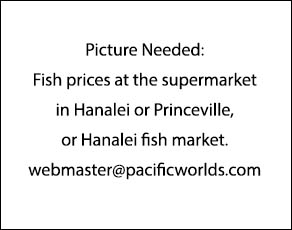 “We still have an abundant—not nearly as abundant, but it is an abundant source—our ocean provides lots of the food that we’re able to get regularly here in Hawai‘i. Food staple, the fish that we gather, and the products we gather from the ocean. Limu—seaweed—shellfish, just the diversity of fish itself that we are able harvest from the ocean. Our markets are full of fish here, which we’re lucky. At one time it was hugely abundant. It’s abundant today, but not like it was once upon a time, which leads to get the price going up. “We don’t have as many fishermen out there as we used to. Fishermen today have so many regulations that they have to adhere to do to be able go out there and catch the fish and bring it back, that guys are just not doing so much it anymore. And so, we have an abundance of fish out there but we don’t have an abundance of guys going out there to get the fish and bring it in. And that is primarily what’s leading to the high cost of fish. “Secondly, in my opinion, is that all of the resorts are buying up all the ahi, all the monchong, all the moonfish, opah, all the deep water fish, middle depth fish and the reef fish—everything. The reef fish, nobody wants that, nobody wants reef fish, so we can go out there all day long and catch reef fish, they don’t want it. They don’t want the manini, they don’t want the aweoweo, they don’t want it. They want the deep-water fish and the mid-depth fish, the opah, the monchong. Those populations just don’t exist at the levels that they used to exist, which is why the cost is so much. “Any food that’s being produced in Hawai‘i right now is mainly sourced through the farmers markets. We are fortunate living here in Hawai‘i: we have a very strong food production system at the local level. If you’re tapped in, you can get access to some really diverse types of foods because of our growing climate here. We get three full growing seasons, and our tropical climate allows us to be able to grow foods from all over the world. So the diversity of food that is potentially available to the local community is great. And if a person is diligent about finding those foods—contacting the rich organic farming community that exists here—the choices are abundant. “But those choices are limited. The access to those food sources are limited. You really have to kind of seek those out, search those out, and in a lot of cases—I know what I’m about to say is kind of controversial and I’ve taken some flak for it before—but when you go to the farmers’ markets here, because of the loose regulation that is placed on them, the folks are organizing these farmers markets aren’t really stringent about whose coming in. At least, they haven’t been in the past. We get food that’s being represented as ‘local organically grown food,’ but there setting up in a box that says ‘Dole,’ and clearly came from places like Costco or other budget market places like that. “So when you go to the markets here, you really need to ask questions, you really need to get to know the farmer and understand the integrity level of the people who are selling food, in order to be able to really get the best quality products. Locally sourced, locally grown that you can get your hands on it. It is possible but it does require some diligence and work. “Farmers Markets are popping everywhere nowadays,” Kaneakua adds. “Local stores. Then there’s the controversy: organic coming from the mainland, or organic local? I mean organic is organic. I shop almost every store to get specific, so I go to one market for the organic carrots, I’ll go to one market for their organic eggs. These are supermarkets. Then I’ll go to local farmers markets to get specifics, every week, whether it’s for myself or my product. I mean, I know where I can get organic bread—I have to order it, right. 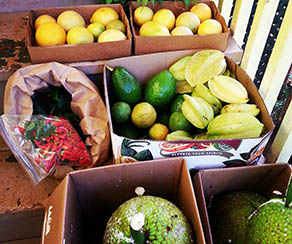
“So it’s not hard, but it takes time. It’s probably not convenient, but for me it’s a lifestyle to go out and hunt good food, from the ocean too. If I’m not in the market, I spend my time at the beach. I still to kind of like to be pole fishing, and if I’m lucky to get something I can go home and make a dinner out of it, I’m excited. Each time another fast food place opens up on the island, I’m like, ‘What about another lo‘i? What about a food farm? Which is eventually what we plan on doing here.” “But at the same time I’m trying to do what’s pono with what I have. It might not be as local as it should be but at least, in my mind, pono doesn’t always mean correct, but at least it means what’s happening at that moment. It’s not always doing the right thing but at least you work with what you have to make things right for that situation. Kaneakua talks about educating youth about food and cooking. “Hawai‘i as a whole is not really producing much food on it’s own,” Donovan affirms. “Which is unfortunate in this day and age. So to be where we’re at today—not a producing nation, not a producing community, having come from one of the most influential food producing societies on the planet—is a really far place to have gone. A long distance away from what we truly we are capable of and can be. “Politically, I know that these situations we face are rooted in the overthrow. And because of the climate that was created by these businessmen who came to Hawai‘i and commandeered the authority of the Hawaiian Kingdom away, they were able to put into place this system that we currently are beholden to. It’s that situation, the 1893 overthrow, that allowed what we see happening today.”
|
 |
|
 |
The overthrow of the Hawaiian Kingdom government in 1893, and the increasingly questioned legality of annexation to the United States, has led to a growing debate over Hawaiian sovereignty that resonates strongly today.
|
 |
||
 |
|
 |
||

|
|
||||
| Copyright 2018 Pacific Worlds & Associates • Usage Policy • Webmaster |
||||
